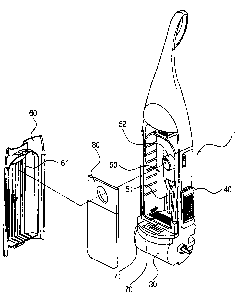Some of the information on this Web page has been provided by external sources. The Government of Canada is not responsible for the accuracy, reliability or currency of the information supplied by external sources. Users wishing to rely upon this information should consult directly with the source of the information. Content provided by external sources is not subject to official languages, privacy and accessibility requirements.
Any discrepancies in the text and image of the Claims and Abstract are due to differing posting times. Text of the Claims and Abstract are posted:
| (12) Patent Application: | (11) CA 2385979 |
|---|---|
| (54) English Title: | AIR FLOW STRUCTURE FOR AN UPRIGHT-TYPE VACUUM CLEANER |
| (54) French Title: | STRUCTURE DE CIRCULATION D'AIR POUR ASPIRATEUR VERTICAL |
| Status: | Deemed Abandoned and Beyond the Period of Reinstatement - Pending Response to Notice of Disregarded Communication |
| (51) International Patent Classification (IPC): |
|
|---|---|
| (72) Inventors : |
|
| (73) Owners : |
|
| (71) Applicants : |
|
| (74) Agent: | SMART & BIGGAR LP |
| (74) Associate agent: | |
| (45) Issued: | |
| (22) Filed Date: | 2002-05-10 |
| (41) Open to Public Inspection: | 2003-07-31 |
| Examination requested: | 2003-12-09 |
| Availability of licence: | N/A |
| Dedicated to the Public: | N/A |
| (25) Language of filing: | English |
| Patent Cooperation Treaty (PCT): | No |
|---|
| (30) Application Priority Data: | ||||||
|---|---|---|---|---|---|---|
|
An air flow structure for an upright-type vacuum cleaner having a body
divided by a partition into a dust-collecting chamber having a dust bag and a
motor
driving chamber having a motor; an air suction port protruded at an upper part
of the
dust-collecting chamber in order to draw air thereinto, and having the dust
bag
disposed around the air suction port; a dust cover to cover the dust-
collecting
chamber and having a plurality of ribs disposed therein in a lengthwise
direction, a
concaved portion formed at a rear wall of the dust-collecting chamber in a
lengthwise direction, and a grill portion formed between the dust-collecting
chamber
and the motor driving chamber in order to allow the air of the dust-collecting
chamber to flow to the motor driving chamber.
Note: Claims are shown in the official language in which they were submitted.
Note: Descriptions are shown in the official language in which they were submitted.

2024-08-01:As part of the Next Generation Patents (NGP) transition, the Canadian Patents Database (CPD) now contains a more detailed Event History, which replicates the Event Log of our new back-office solution.
Please note that "Inactive:" events refers to events no longer in use in our new back-office solution.
For a clearer understanding of the status of the application/patent presented on this page, the site Disclaimer , as well as the definitions for Patent , Event History , Maintenance Fee and Payment History should be consulted.
| Description | Date |
|---|---|
| Application Not Reinstated by Deadline | 2007-08-17 |
| Inactive: Dead - Final fee not paid | 2007-08-17 |
| Deemed Abandoned - Failure to Respond to Maintenance Fee Notice | 2007-05-10 |
| Deemed Abandoned - Conditions for Grant Determined Not Compliant | 2006-08-17 |
| Inactive: IPC from MCD | 2006-03-12 |
| Notice of Allowance is Issued | 2006-02-17 |
| Letter Sent | 2006-02-17 |
| Notice of Allowance is Issued | 2006-02-17 |
| Inactive: Approved for allowance (AFA) | 2006-01-10 |
| Letter Sent | 2003-12-22 |
| Request for Examination Requirements Determined Compliant | 2003-12-09 |
| All Requirements for Examination Determined Compliant | 2003-12-09 |
| Request for Examination Received | 2003-12-09 |
| Application Published (Open to Public Inspection) | 2003-07-31 |
| Inactive: Cover page published | 2003-07-30 |
| Inactive: First IPC assigned | 2002-08-08 |
| Inactive: Filing certificate - No RFE (English) | 2002-06-20 |
| Letter Sent | 2002-06-20 |
| Application Received - Regular National | 2002-06-20 |
| Abandonment Date | Reason | Reinstatement Date |
|---|---|---|
| 2007-05-10 | ||
| 2006-08-17 |
The last payment was received on 2006-04-13
Note : If the full payment has not been received on or before the date indicated, a further fee may be required which may be one of the following
Patent fees are adjusted on the 1st of January every year. The amounts above are the current amounts if received by December 31 of the current year.
Please refer to the CIPO
Patent Fees
web page to see all current fee amounts.
| Fee Type | Anniversary Year | Due Date | Paid Date |
|---|---|---|---|
| Registration of a document | 2002-05-10 | ||
| Application fee - standard | 2002-05-10 | ||
| Request for examination - standard | 2003-12-09 | ||
| MF (application, 2nd anniv.) - standard | 02 | 2004-05-10 | 2004-04-19 |
| MF (application, 3rd anniv.) - standard | 03 | 2005-05-10 | 2005-04-26 |
| MF (application, 4th anniv.) - standard | 04 | 2006-05-10 | 2006-04-13 |
Note: Records showing the ownership history in alphabetical order.
| Current Owners on Record |
|---|
| SAMSUNG KWANGJU ELECTRONICS CO., LTD. |
| Past Owners on Record |
|---|
| HYUNG-IL JEON |
| IL-WON YANG |
| JUNG-SEON PARK |